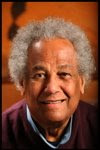Review - Ian Dieffenthaller WASAFARI 2002

Ring of Steel traces the development of the steelpan: “The only acoustic musical instrument to be invented in the 20th century”. Grant’s book, which describes the transmutation of industrial waste – the oil drum – into highly tuned musical instrument, is offered as a paradigm for the development of the latter-day West Indian from an initial “collision of cultures”. We are not asked to read once for facts and again for this insight. Instead the story is a holistic one, its various strands being neatly woven together. Significantly the book opens with Grant’s poem Anansi the wise spider-man. Anansi is the West Indian trickster, a spider figure, who spins his webs at cultural boundaries. In literature, the boundary is often that of Great house (coloniser) and Folk (colonised) and the resulting “plantation model” is extended to represent all society’s sites of oppression (colonisation of women or the mind for example). Grant’s Anansi tells us of “Ogun/god of war and iron;/how one day his voice will resonate/through his son/Pan/spiralling outwards spanning the globe/a ring of steel/a healing web of sound".
Chapter One sketches Trinidad’s cultural development, explaining the unusual mix of French, English and Spanish settlers and how African and Indian traditions survive, despite colonial attempts at suppression, in religion, music and language. It defines the unique Carnival as an appropriation of European Catholicism by these “other” traditions and tells of the rise of the tamboo bamboo band following the 1884 Act banning African drums. Bamboo is cut to different lengths to produce three instruments which are struck on the ground or against each other. The bands co-existed with and were eventually superseded by “iron” bands comprising “ tin containers of all sorts”. No one knows who discovered that dented tins could produce musical notes but the first turned pan is credited to Winston “Spree” Simon in 1946.
“Behind the Bridge”, in Port of Spain’s poorest ghettos the “pan yards” became the focus of each community. Experimentation “produced a plethora of instruments”, all with different names such as ping pong, dudup, grunding…” and good pans became prizes worth fighting over. Violent “clashes between bands mirrored the territoriality of the urban landscape and the violence that society continually meted out to the underprivileged”. As Anansi would have it, it was the intervention of middle-class college boys and the involvement of women players and organisers that took pan to its international debut at the Festival of Britain. Though at first “people smiled indulgently”, it was an unqualified success. Yet pan and its culture remained reviled at home. Grant chronicles the slow road to acceptance and role-calls all its pioneers.
At the book’s core is an exhaustive exposition of pan-making and the various types of pan, and a description of the way the band is structured around an “engine room” of percussion. Grant outlines the science and musicology of steelpans, the most thrilling aspect of which for him is that steel when tempered is able to generate harmonics. This phenomenon, absent from other metallic instruments, symbolises the alchemy in the change from industrial waste to necessary component in WI culture.
The book addresses the influences of sponsorship and politics, the touristic trivialising of the instrument and the loosening of its integral role in carnival, leading commentators to predict the death of pan. Grant, however, charts the rise and continuing evolution of the instrument in places as unexpected as Switzerland. He debates whether the teaching of pan should be by rote, as is traditional, or by reading music; and speculates on the healing power of the harmonic overtones themselves. Should pan be solo or form part of a “steel orchestra”; should it play calypso or classics? He investigates the meaning and role of Carnival and the importance of all cultures, European, African and Asian to its continued existence.
“Kaiso, pan and mas are the cultural expression….drawing its conviction from the oneness of life and art. There is no separation as in the Western Tradition (p73). There are no passive receivers of the culture”.
The story of pan, is that West Indian culture, perceived subversively as part of a trinity, has the power to heal “rifts within a divided society” and that the continued evolution of pan is vital to “an evolving sense of identity and culture” unavailable in the West. Consequently, the illustrations in the book are, apart from Las Casas on Columbus, all from poets, novelists and calypsonians, never from official documents or newspapers. Grant allows the artists to recreate the places, events and people of his mythic history, much as Kamau Brathwaite employs the “folk” in defining “voice” in West Indian poetry. It is testament to Grant’s ability as poet and calypsonian that he is able to locate pan’s voice within the text of a sound technical exposition of an instrument.
For Grant the West Indies, a meeting place of cultures, is a site of myth making: Pan is present in Ogun. This book should be essential for those who want to tap into the creative potential of such sites.
MacMillan 1999, 120pp, 1SBN 0 – 333 – 66128 – 1; £13.50

1 comment:
Just finsished Cy Grant's new book, "Our Time Is Now."
Wow. A brilliant set of essays.
Post a Comment